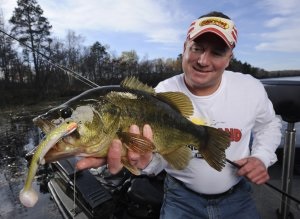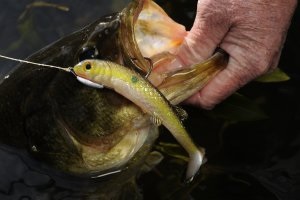 The North Country’s Answer to a West Coast Phenomenon. “In places where we used to throw spinnerbaits, we’re now swimming a Slurpies Rock-R-Minnow swimbait with mind-boggling results,” stated Team Northland tournament ace Jeff Gustafson. “Especially in tournaments, we’re catching a lot of really big bass.”
The North Country’s Answer to a West Coast Phenomenon. “In places where we used to throw spinnerbaits, we’re now swimming a Slurpies Rock-R-Minnow swimbait with mind-boggling results,” stated Team Northland tournament ace Jeff Gustafson. “Especially in tournaments, we’re catching a lot of really big bass.”
 The West coast sensation of pitching supersized swimbaits for hulking largemouths is far from new, of course. More recently, however, anglers across North America have begun to embrace a swimbait subcategory: 4 to 6-inch hollow-bodied swimmers sporting wide, flat paddletails.
The West coast sensation of pitching supersized swimbaits for hulking largemouths is far from new, of course. More recently, however, anglers across North America have begun to embrace a swimbait subcategory: 4 to 6-inch hollow-bodied swimmers sporting wide, flat paddletails.
Yet while most of these hollow-bellied swimbaits yield a distinct side-to-side roll that certainly attracts fish, anglers have also discovered that the baits don’t hook bass particularly well. Indeed, many of the hollow-bodied baits have shown a tendency to ball up inside a bass’s mouth. When this happens, the hook point inevitably buries itself back into the thick-walled plastic, rather than the fish’s jaw.
Fortunately for anglers, vital design innovations have produced an extraordinary, singular design, similar to the original hollow-bodied baits, yet superior in nearly every respect. “Since we introduced the Slurpies Rock-R-Minnow several months ago, my phone’s been ringing off the hook with anglers demanding more packs of these things,” said Northland Fishing Tackle Brand Manager and bass pro, John Crane. “These are top-shelf fishermen, too—some of the best bass anglers in the Midwest. I don’t think fish have seen anything quite like these Rock-R-Minnows yet.”

Crane continued: “What we wanted was a bait that was easy for anyone to fish, and simple to rig, even while traveling fast in a boat. It had to be weedless, too. And we knew we had to make this bait hook bass much better than the hollow-bodied versions.”
The solution, according to Crane, was to give the bait a slotted, open belly, including a notched dorsal opening for allowing the hook to effortlessly slide through and penetrate jaw flesh. At the same time, Crane said, this special dorsal slot insets the hook point slightly during the retrieve, yielding a clean, snag-free presentation.
In addition, the bait features a tough, semi-rigid head that holds up well with a variety of rigging options. Married to Northland’s 6/0 screw-lock Lipstick hook, for example, the Rock-R becomes a pretty durable softbait. “We’ve had anglers tell us they’re catching over a dozen bass on a single bait,” Crane relayed. “For a softbait, that’s pretty impressive.”
Unlike original hollow-bodied baits, whose portly, tubular shapes aren’t specifically imitative of anything in nature, these new generation swimbaits feature a lean, baitfish-mimicking profile, complete with distended gill covers, supple, rippling fins, and other anatomically-correct features. In a lure category renowned for realism, swimbaits like the Slurpies Rock-R-Minnow are apparently proving worthy of the name.

Moreover, they’re among the only paddletail swimbaits available whose shape closely mimics the soft-rayed preyfish preferred by predators: shiners, ciscoes, alewives, shad, blueback herring, and gobies. Even the bait’s material is softer and more pliable, relative to hollowbodied baits, whose plastic often feels slightly rigid to the touch. Of course, the real difference lies in underwater action, performance, and ultimately, fish appeal. “The Rock-R-Minnow’s naturally soft texture yields a fluid yet seductive wobble that really appeals to big bass,” offered Gustafson, who won the highly-competitive 2008 Kenora Bass International (KBI) event on Lake of the Woods, Ontario.
“We discovered during development that the slotted body of the Rock-R-Minnow produced a much more dynamic swimming action than the hollow-body versions. Not only that, but the bait held up to many more strikes and fish catches. That’s critical in North Country waters where all kinds of toothy predators swim—walleye, pike, muskies, plus smallmouths and largemouths. They all love these swimbaits.”
For working the bait faster over shallow cover-laden flats—places you’d normally throw a spinnerbait—most anglers prefer a 3/16-ounce weighted swimbait hook, as opposed to a lighter 1/8-ounce. “With the added weight, it’s possible to rocket out some pretty long casts, Gustafson offered. “Still, to fish these baits effectively, you have to use the right equipment. I like a 7’2” medium-heavy Shimano Cumara casting rod teamed with a Shimano Curado reel, which has a 7:1 gear ratio, and 20-pound fluorocarbon. Lighter 15-pound test works for openwater and smallmouths.”
Cast and simply begin reeling at a steady rate, pausing to “kill” the bait near high spots on the flat, or close to cover objects such as stumps or weed clusters. “When bass strike these baits,” Crane said, “they usually engulf them entirely. Just drop your rod back toward the fish, reel up, and sweep the hookset until your rod loads into a deep bend. Lots of times, these are really big fish.”
“Some of the region’s top anglers are using Slurpies Rock-R-Minnows in competition, but they haven’t been telling anyone. Well, other than us, that is,” Northland’s Crane recalled with a grin. “And they’re only telling us because they need more baits.”
